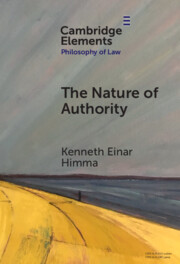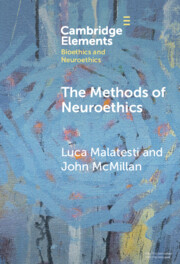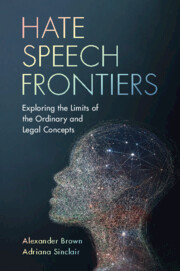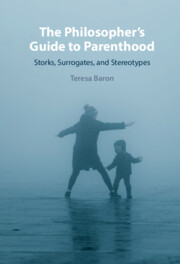Refine search
Actions for selected content:
29 results
Introduction
-
- Book:
- Truth and Reference in the Making of Fiction
- Print publication:
- 22 January 2026, pp 1-13
-
- Chapter
- Export citation
6 - Private Law beyond the Law
- from Part II - Reinach and Private Law Theory
-
-
- Book:
- Reinach and the Foundations of Private Law
- Published online:
- 20 July 2025
- Print publication:
- 07 August 2025, pp 150-165
-
- Chapter
-
- You have access
- Open access
- HTML
- Export citation
5 - The Limits of Experimental Jurisprudence
- from Part I - Foundations and Theory
-
-
- Book:
- The Cambridge Handbook of Experimental Jurisprudence
- Published online:
- 17 May 2025
- Print publication:
- 05 June 2025, pp 79-91
-
- Chapter
- Export citation
6 - Competing Conceptual Inferences and the Limits of Experimental Jurisprudence
- from Part I - Foundations and Theory
-
-
- Book:
- The Cambridge Handbook of Experimental Jurisprudence
- Published online:
- 17 May 2025
- Print publication:
- 05 June 2025, pp 92-109
-
- Chapter
- Export citation
6 - Property’s Conceptual Structure
- from Part II - The Natural Right to Property
-
- Book:
- Natural Property Rights
- Published online:
- 17 April 2025
- Print publication:
- 24 April 2025, pp 105-127
-
- Chapter
- Export citation
Chapter 8 - Presuppositional Analysis and the Goal of Metaphysical Inquiry
- from Part II - Issues in Collingwood’s Philosophy
-
-
- Book:
- Interpreting R. G. Collingwood
- Published online:
- 22 November 2024
- Print publication:
- 05 December 2024, pp 143-160
-
- Chapter
- Export citation

The Nature of Authority
-
- Published online:
- 04 December 2024
- Print publication:
- 09 January 2025
-
- Element
- Export citation
Chapter 2 - The Place of Concepts in Socratic Inquiry
-
-
- Book:
- Conceptualising Concepts in Greek Philosophy
- Published online:
- 25 April 2024
- Print publication:
- 02 May 2024, pp 35-55
-
- Chapter
-
- You have access
- Open access
- HTML
- Export citation
4 - Exposition, Conceptual Analysis, and Apperception
-
- Book:
- Intuition in Kant
- Published online:
- 07 March 2024
- Print publication:
- 14 March 2024, pp 110-131
-
- Chapter
- Export citation
6 - Prolegomena to a Stufenleiter of Kantian Intuition
-
- Book:
- Intuition in Kant
- Published online:
- 07 March 2024
- Print publication:
- 14 March 2024, pp 173-193
-
- Chapter
- Export citation

The Methods of Neuroethics
-
- Published online:
- 12 January 2024
- Print publication:
- 08 February 2024
-
- Element
- Export citation
3 - Attacks against Groups
- from Part I - The Ordinary Concept
-
- Book:
- Hate Speech Frontiers
- Published online:
- 26 October 2023
- Print publication:
- 09 November 2023, pp 88-208
-
- Chapter
- Export citation
1 - Conceptual Frontiers in the Understanding of Hate Speech
-
- Book:
- Hate Speech Frontiers
- Published online:
- 26 October 2023
- Print publication:
- 09 November 2023, pp 1-44
-
- Chapter
-
- You have access
- HTML
- Export citation
2 - Prototypical Examples of Hate Speech
- from Part I - The Ordinary Concept
-
- Book:
- Hate Speech Frontiers
- Published online:
- 26 October 2023
- Print publication:
- 09 November 2023, pp 47-87
-
- Chapter
- Export citation
4 - Attacks on the Identities of Groups
- from Part I - The Ordinary Concept
-
- Book:
- Hate Speech Frontiers
- Published online:
- 26 October 2023
- Print publication:
- 09 November 2023, pp 209-326
-
- Chapter
- Export citation

Hate Speech Frontiers
- Exploring the Limits of the Ordinary and Legal Concepts
-
- Published online:
- 26 October 2023
- Print publication:
- 09 November 2023
2 - Stanley Cavell as Methodologist
-
- Book:
- Stanley Cavell's Democratic Perfectionism
- Published online:
- 17 August 2023
- Print publication:
- 31 August 2023, pp 55-97
-
- Chapter
- Export citation
Spirituality is “sometimes just a hug”: A conceptual analysis from the perspective of nursing students
-
- Journal:
- Palliative & Supportive Care / Volume 22 / Issue 6 / December 2024
- Published online by Cambridge University Press:
- 12 July 2023, pp. 1685-1692
-
- Article
-
- You have access
- Open access
- HTML
- Export citation

The Philosopher's Guide to Parenthood
- Storks, Surrogates, and Stereotypes
-
- Published online:
- 15 January 2023
- Print publication:
- 05 January 2023
Introduction
-
- Book:
- The Philosopher's Guide to Parenthood
- Published online:
- 15 January 2023
- Print publication:
- 05 January 2023, pp 1-14
-
- Chapter
- Export citation
